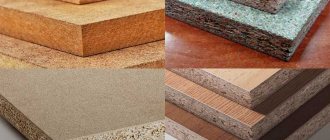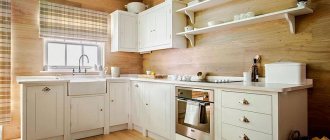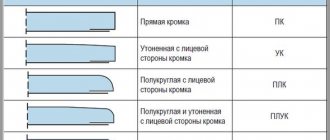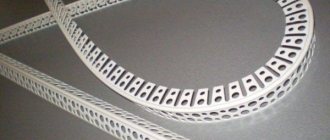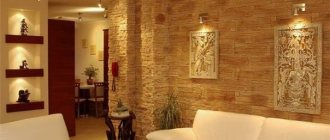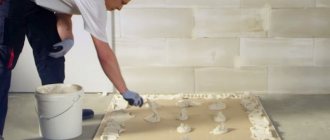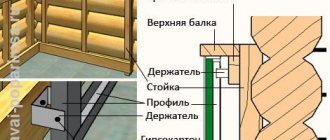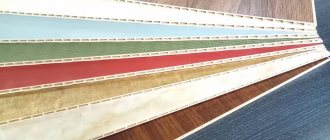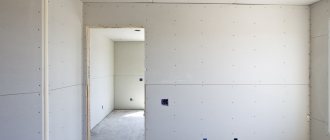What is chipboard
For the production of particle boards, small fragments of wood and synthetic resins are used: formaldehyde or phenol-formaldehyde compounds. The hot pressing method allows you to connect these components together and then form them into slabs of the required size. A laminated coating can be applied on top of the slab. Thanks to its presence, the slab is less subject to mechanical stress and acquires a presentable appearance by simulating the structure of wood.
If we compare sawdust boards with natural wood, they have a number of advantages. Uniformity of composition and uniform rigidity over the entire sheet area are some of them. Synthetic resins in the composition allow for the installation of fasteners. From a safety point of view, a material can be considered environmentally friendly if the product certificate indicates emission class E1.
Features and rules for installing tongue-and-groove moisture-resistant chipboard
When rough finishing various surfaces, many requirements are placed on the material used. One of the main ones is resistance to humidity. Tongue-and-groove moisture-resistant chipboard will be an excellent solution. Although the product appeared relatively recently, it has already gained great popularity. This is due to its good performance characteristics and the possibility of installation on different types of bases.
What is chipboard with tongue and groove?
The abbreviation stands for “chipboard”. It is obtained by hot pressing of a base mixed with binding resins. To obtain additional protection from moisture, a polymer component is added to the mass.
Unlike other varieties, the product is equipped with a tongue and groove. The design of the connection consists of a protrusion and a groove at the ends of the part, due to which it is possible to connect the elements extremely reliably, avoiding distortions and disruption of the plane at the joints. This method allows you to obtain a solid surface that is less susceptible to various influences due to a more even distribution of the load.
Connecting elements through a tongue and groove has been practiced for several decades and has proven its quality, reliability and durability
Advantages and disadvantages of chipboard wall panels
Chipboards have gained popularity due to their positive quality characteristics:
- a huge selection of colors and textures;
- possibility of painting after installation;
- no special care products are required;
- installation is carried out in the shortest possible time without any special difficulties;
- reasonable prices, allowing a buyer with a small budget to choose the right material;
- withstands exposure to high temperatures and direct sunlight, exhibits resistance to mechanical stress and abrasion;
- have a presentable appearance (chipboard), which lasts for a long time.
Like any material, chipboard is not without its drawbacks:
- cannot withstand sudden changes in temperature conditions;
- exposure to moisture negatively affects the material, so it is not recommended to use it in rooms with high humidity;
- the ends need to be edged to hide the cut of the slab and protect it from moisture penetration;
- holes cannot be used several times;
- not strong enough for installation of heavy structures.
All about the installation of chipboard wall panels in interior decoration
In the design of premises at the moment there is a real trend towards abandoning plaster and other “wet” works in favor of other areas of finishing - the installation of hanging structures. High demand immediately turned into a wide supply, and at the moment on the domestic construction market there are options for hinged panels to suit every taste and every wallet thickness. And chipboard panels are one of them
Brief information about this finishing method
Chipboard - chipboard, as the name implies, is a material created from small fragments of wood. Well-dried sawdust is combined into slabs using hot pressing. In this case, the individual fragments are bonded to each other through the use of synthetic resins. In the role of the latter, phenol-formaldehyde and formaldehyde compositions are used, the amount of which in finished products varies from 6 to 18 percent.
A little about formaldehyde
The presence of these resins not only makes the slabs we are considering strong and durable, but is also the subject of controversy regarding the environmental friendliness of the material. Formaldehyde is a colorless gas with a pungent, characteristic odor. It can stand out due to similar materials, from which, by the way, a considerable part of the furniture around you is made. At the same time, the gas is harmful to the respiratory, visual, nervous and other systems of our body, and is also a carcinogen.
It would seem that purchasing anything created using phenol-formaldehyde and formaldehyde resins is strictly prohibited. But in reality this is not the case, because the adhesive itself for using chipboard can be of different types, corresponding to the E1 or E2 markings.
The first means that the release of this gas during operation will be so insignificant that such components can be used even when decorating or producing furniture for children's rooms.
In addition, there is also a Super E class, in which the formaldehyde emission rates are as low as possible, and these types of particle boards can be used in any direction.
Many Russian manufacturers are trying to use these high standards adopted in Europe, where safety is taken extremely seriously. Therefore, such products do not pose a health hazard. And all the talk about the harmfulness of this material is nothing more than a generalization.
Advantages and disadvantages of chipboard wall panels
- Resistance to high temperatures, sunlight, and physical impact. Chipboard-based panels do not wear out and retain the appearance of a new product for as long as possible;
- The panels have an attractive and solid appearance. In addition, they are suitable for further finishing, for example, for painting;
- A large number of design possibilities. The panels can be covered with a variety of materials: laminate, veneer or leather;
- Practicality in care;
- High sound insulation characteristics;
- Easy installation;
- Low price.
The disadvantages of these panels, as well as all those products that are based on wood and its components, are insufficient resistance to moisture.
So the use of this product for finishing rooms with high levels of humidity is not recommended (unless we are talking about special moisture-resistant options, the ends of which are insulated). As in external finishing, since in addition to humidity, chipboards are also not adapted to temperature changes.
In addition, the strength of chipboard is lower compared to wood, the material cannot withstand hanging heavy structures, and the holes that were previously made in it cannot be used again. Finally, the sides of the material need finishing, as their appearance is very unpresentable.
Types of finishing coating
- Depending on the direction of use, needs and personal preferences, you can choose one of several finishing coatings for wall slabs:
- If you are looking for a variety of modern designs that can be easily maintained, then laminated models are ideal. Using laminate you can imitate almost any surface;
- If it is necessary to give the room a solid look, you can use veneer (a thin cut of elite wood) or leather. Leather can be either artificial or natural, and its only visual drawback is the small number of color and texture variations;
- If panels are used for a high level of sound insulation, you can choose a special chipboard with a perforated surface. Moreover, such sheets can be covered with veneer or polymers on top.
Methods for attaching chipboard sheets to walls
- Application of sheathing. The most common method involves installing wooden sheathing elements on the wall, secured with dowels. At the same time, chipboard panels are adjusted to the sheathing itself using self-tapping screws. The good thing about this method is that it allows you to avoid leveling the walls and not having to clean and degrease the surface. The only thing they recommend doing is to treat the wood sheathing itself with an antiseptic before installation;
- Glue. The easiest way to finish walls in terms of time and financial costs. But only if the walls are perfectly smooth and do not contain problem areas. Otherwise, it will be necessary to first clean the walls of previous coatings and dust, as well as degrease and prime them;
- Using a profile. Before fixing the panels, an aluminum profile consisting of horizontal and vertical components is mounted on the wall. The chipboard sheets themselves are already mounted in its grooves. In this case, the profile is attached to the wall using dowels, and the sheets are simply held on it, fixed by a metal structure. In this case, part of the profile is visible between the sheets, which can serve as an additional visual detail;
- Hardware method. Used when mounted on a wooden or perfectly flat base. During installation, you can use a construction stapler.
Conclusion
In terms of price and quality ratio, chipboard panels can be an ideal solution for wall decoration. However, it is necessary to purchase only high-quality products of this kind that have all the necessary certificates.
Source: https://bricknews.ru/article/3819
Fastening chipboard sheets to walls
To attach the panels to the surface, you need to use one of four possible methods:
- Using a wooden frame, you can level the walls and also hide utility networks. It is recommended to pre-treat the sheathing with special compounds to extend its service life. Using dowels, the frame is fixed to the surface, after which the panels are attached using self-tapping screws.
- Aluminum profiles allow the installation of laminated particle boards in rooms with high humidity. Installing the slabs is not difficult. First, the profiles are installed on the wall, and then the sheets are fixed on them.
- When the base is flat or wooden, staples are excellent as fasteners. Installation is carried out using a special construction stapler.
- If the adhesive method is used, you must first prime the walls and treat them with antiseptic agents. The surface must be flat. A distinctive feature of installation is speed and ease. But it will not be possible to dismantle the sheets without damage.
Installation can be done directly on the wall or on a wooden frame. In the latter case, it becomes possible to lay a thermal insulation layer. If connecting profiles are used, they can be unpainted or painted in the color of the panel or in a contrasting color.
Preparatory stage
Any installation method begins with a preparatory stage. The work involves cleaning the wall of all unnecessary things, eliminating finishing defects, leveling the surface, priming, and treating with special compounds. In particular, wooden surfaces are impregnated with fire retardants. Even before installation, possible shrinkage of the building is taken into account, so a gap is provided between the floor and ceiling. It is best to mark future fixation points so that all attachment points are on the same level. If you plan to install it with glue, then the sheet is processed until rough on the reverse side with sandpaper.
How to cover walls with chipboard panels | Finishing experts
Gusevsky Andrey Anatolievich
This is what wall cladding with chipboard panels might look like
Increasingly, when finishing internal and external walls, hanging installation methods have begun to be used, eliminating plastering, leveling and other “wet” work. It is much easier, faster and cleaner to cover them with panels or sheet materials. One of these materials is chipboard cladding panels, the types, features and installation methods of which will be discussed in this article.
Chipboard repair at the attachment point
There are situations when, for some reason, it is not possible to make holes in the right place, or the attachment point deteriorates over time, becomes loose and loses strength. Then you have to tidy up the slab and hide unnecessary holes. When you need to plug a hole so that you don’t use this place in any way in the future, you need to expand it to 8 mm, then fill it with PVA glue and insert a dowel. Once everything is dry, you can paint over the area to be repaired with a wax pencil of the appropriate color.
If the hole is small, then you can use Epoxylin, carefully covering the holes and painting with the desired color after drying.
Thus, acting in accordance with the methods presented above, you can not only fix the slabs on the wall, but also connect them together and seal unnecessary holes.
Furniture screed is used only in furniture production. When making furniture, you should not use traditional fasteners instead of furniture ties, because it has special properties that not only facilitate the assembly of furniture, but also allow you to hide the fasteners. Next, we will consider the most commonly used types of furniture screeds and their features.
Content
Tabletop fasteners
A special type of furniture tie used to secure two parts of a tabletop together. It is used exclusively in the production of kitchen furniture and requires special milling of surfaces before installation.
To ensure high quality assembly and installation of interior elements, furniture fasteners are used. Depending on the location of fixation and method of connection, there are several varieties. These elements not only make the assembly and installation procedure easier, but will also be invisible after the process is completed.
Confirmat
The most common type of fastener is confirmat. At the same time the easiest to use. With its help, assembling furniture is easier and faster than using other types of furniture screed. Especially if during assembly you have to drill holes for fasteners yourself. Using a confirmat, two parts are connected at an angle of 90 degrees.
In order to tighten the two parts, you need to drill two holes. One in one part, with a diameter equal to the diameter of the confirmator head, the other, at the end of the second part, with a smaller diameter equal to the diameter of the threaded part.
As a rule, drills with a diameter of 6 and 5 mm are used for this, respectively. However, there is a combination drill available for drilling holes at the same time. It is very comfortable. There is no need to constantly rearrange drill bits or use two drills at the same time.
Confirmat is a universal fastener, but it has some disadvantages and application features.
Confirmat should be used simultaneously with the use of dowels. A dowel is a wooden rod with a diameter of 6-8 mm and a length of 20-30 mm (in the photo below, next to the confirmation). The dowel acts as a guide and does not allow parts to move during tightening.
Despite the fact that furniture assembled using confiramate can be assembled or disassembled, furniture made from laminated chipboard does not tolerate this very well. As a rule, after one disassembly, the furniture screed no longer holds well.
The confirmation should be wrapped carefully. The best option is by hand or with a screwdriver at low speed. Otherwise, the confirmation thread turns into a drill, which breaks the hole.
In order to recess the head into the body of the furniture part, you should use a wrench and do it carefully, otherwise there is a possibility of the thread breaking. Sometimes it is necessary to pre-calculate.
Con fasteners. Those. Unlike other types of fasteners, it remains visible, so it is necessary to use special plugs or stickers to hide the fasteners.
Eccentric coupler
An eccentric coupler is often used in the factory production of furniture. The reason for this is the difficulty of drilling holes. An eccentric coupler consists of two parts: a pin and an eccentric. The pin is installed in one part, and the eccentric in another.
The main advantage of this type of fastener is that this fastener is hidden and therefore does not spoil the appearance of the furniture. In addition, this type of fastener, unlike confirmat, allows you to repeatedly assemble and disassemble furniture, which is important, for example, when moving. Also, using an eccentric coupler, you can connect parts at different angles.
Varieties
The design and type of fastener will depend on the purpose of the furniture on which it is fixed. The elements can hold the product together inside, creating its frame, and also secure the base of the furniture to the wall or floor. Today the following types of fasteners are used:
- Furniture corner;
- Confirmation;
- Dowel;
- Screeds;
- Shelf supports;
- Bolt nut.
Each of these types has its own characteristics and features that distinguish them from each other. To find out which element is needed to assemble furniture, it is recommended to consider in detail the advantages and disadvantages of each category.
Furniture corner
This element belongs to a simple and outdated type of furniture fastener. It would seem that if a detail is outdated, then why talk about it? It's simple - such a corner will be useful for beginning assemblers. He will also become an assistant in the independent design of furniture products and subsequent assembly. In addition, its installation does not require any special equipment or skills. According to the production material, there are 2 types of furniture corners:
- Plastic - fastened with self-tapping screws, has a more miniature appearance and is relatively light weight. This corner is convenient to use for fastening light furniture panels or for supporting furniture parts;
- Metal - has stiffening ribs and is produced at an angle of 90 degrees. To fix the part, plastic or metal screws and couplings are used. There are holes on one side of the corner and grooves on the opposite side.
Such fasteners are used to connect the roof or bottom of a sliding wardrobe with its walls or when assembling cabinet kitchen furniture. Plastic options are equipped with a special plug, which gives the product a finished look. Metal ones are considered affordable and very durable. The disadvantages of fastening include the gradual loosening of surfaces secured with corners, as well as an unattractive appearance.
Confirmat
This name is usually used to refer to ordinary furniture screws. In another way they are called euroscrews, as well as euroscrews. The fastener is easy to install and does not require precision; a screwdriver or drill is required to fix it. In the screw head there is a hole for a hex key, which is also necessary for work.
To install this part, you need to drill two holes: one in the end of the part, and the other in the element that will be attached. The ease of assembling furniture using a confirmat allows the furniture maker to drill holes on site. It takes a minimum of time to complete the job. You can simplify the process as much as possible if you use a special drill for confirmation for installation. However, many furniture makers claim that over time this device becomes loose and the cutters become clogged with wood shavings. Therefore, for frequent use, standard drills are used.
The most popular and used confirmat size is 7x50 mm. Below are the pros and cons of using this fastener.
| Advantages | Flaws |
| Easy installation, no special equipment required. | The confirmation hat will be visible if it is not covered with a cap that matches the color of the furniture. |
| The fasteners provide excellent connection between the parts. | The fastener cuts threads in the chipboard material and can deform it. |
| Able to withstand increased loads. | Furniture fastened with a confirmat cannot be assembled and disassembled more than 3 times. |
| If desired, the part can be corrected using a mallet. |
Based on the information provided, it is worth noting that these furniture fastenings are convenient and reliable. But if you can use them, then it is better to give preference to an eccentric coupler.
Dowel
Hidden types of fastening are a feature of furniture assembled using dowels. This is a small wooden cylinder, its dimensions are often 35x8 mm. The first number shows the height of the element, and the second indicates the diameter of the fastener. The essence of fastening with dowels is as follows:
- Holes are drilled in each of the two parts;
- The holes must be coaxial - that is, coincide in the location of the axis;
- A dowel is inserted into one hole, which only goes halfway deep;
- A second piece of furniture is placed on the cant protruding from the furniture piece - this is how they are tied together.
In order for the connection to have increased strength, the hole is treated with PVA glue, which additionally fixes the dowels and makes them motionless. The big advantage of this type of furniture fastener is that it remains invisible: it cannot be seen from the outside or the inside. The dowel connection has some disadvantages: it is done once, so it is extremely difficult to disassemble such furniture without damage. The second disadvantage is that precise drilling of holes is required for a perfect fit of the two components. This nuance creates the need to use special devices.
Devices for installing dowels are called conductors. They can be factory-made or home-made. The former are considered the best in quality, but the latter can be made independently.
Ties
Today, there are two main types of furniture screeds - eccentric and intersectional. It is necessary to consider in more detail each of these types separately:
- Eccentric tie – this element is used only in conditions of factory assembly of furniture. To place it on a furniture panel, you need to use a device to drill an exact hole. The main advantage of such fasteners is the ability to remain invisible, then the furniture acquires a neat and attractive appearance. Another advantage, compared to confirmed ones, is that such furniture fasteners allow you to assemble and disassemble furniture several times without losing rigidity. In addition, using an eccentric coupler it is possible to fasten parts at an angle;
- Intersectional tie - represented by a screw and a nut, with the help of which two perpendicular furniture elements are tightened. An intersectional screed is convenient for fixing the headboard and bottom of the bed, as well as tabletops. It is necessary to select fasteners based on the thickness of the particle board.
Types, depending on the material to which it is attached
Modern manufacturers today use not only chipboard to make furniture. Glass, metal parts, and plastic elements are widely used. Fastenings for furniture made of chipboard were discussed throughout the material, and options for fastening objects made from other raw materials are discussed below:
- Glass - screw-type holders are used that are screwed into a wall made of concrete or plasterboard. They are used to fix shelves and mirror surfaces without damaging the coating of the part. For glass doors on the cabinet, the use of furniture hinges is suitable;
- Metal – screw fastenings are used to connect the shelves of metal racks. They are screwed into the racks using a drill or screwdriver. An attractive cap is installed on the front side;
- Plastic – plastic parts can be secured using any chipboard fasteners.
Separately, it is worth highlighting the dovetail fastening - it is used to connect drawers. The essence of the connection is to cut out a comb surface on each part, which is inserted into another part, resulting in end-to-end fixation. Choose only the type of fastening that suits you best. Before purchasing, be sure to calculate the thickness of the material so that during the assembly process screws and screws do not protrude on the surface.
Shelf supports
As you can guess from the name, such fasteners are used to fix shelves (both glass and plastic) of a wardrobe or kitchen cabinet.
Depending on the installation method, shelf holders are divided into open and hidden. The former are mounted directly to the pieces of furniture (after which a shelf is placed on them), while the latter are something like an eccentric coupler.
Shelf holders in the closet, photo:
The fittings that you see in the photo above are intended for attaching shelves in the closet.
